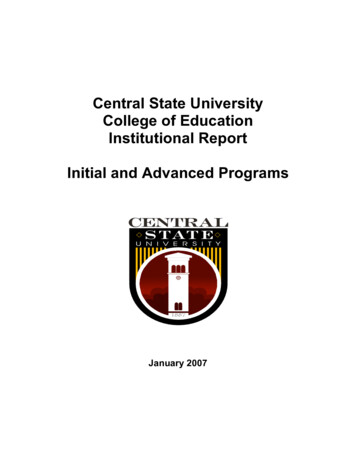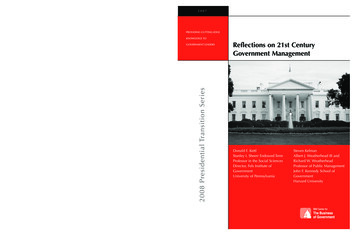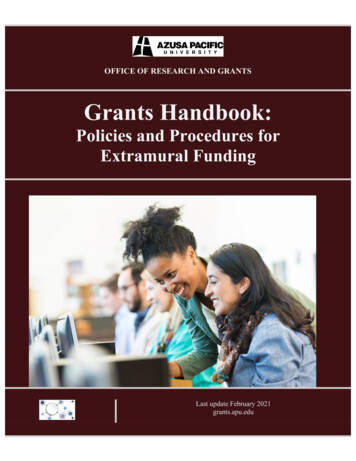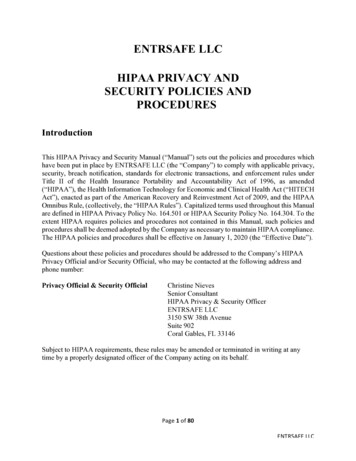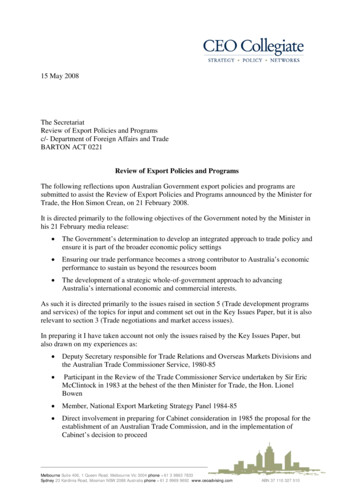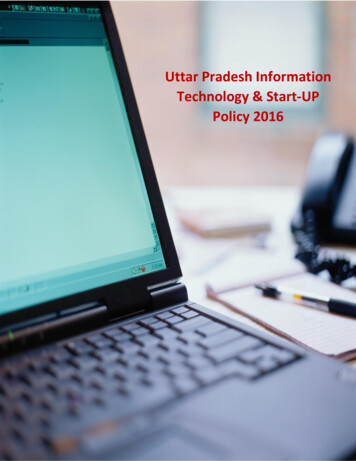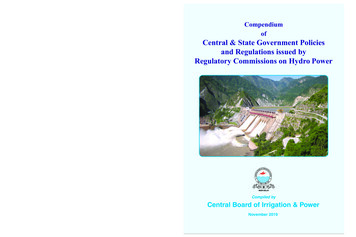
Transcription
CompendiumofCentral & State Government Policiesand Regulations issued byRegulatory Commissions on Hydro PowerCompiled byCentral Board of Irrigation & PowerNovember 2019
CompendiumofCentral & State Government Policiesand Regulations issued byRegulatory Commissions on Hydro PowerCompiled byCentral Board of Irrigation & PowerNovember 2019
ContentsHydro PoliciesSl. No.State NamePolicy NamePage No.Hydro Comparative Sheetvii1Ministry ofPowerHydro Power Policy, 200832ArunachalPradeshSmall Hydro Power Policy, 20079Hydro Power Policy – 2008133AssamPolicy for Development of Small Hydropower (SHP) 2007174BiharBihar Policy for Promotion of Bihar New and Renewable EnergySources 2017195GujaratGujarat Small Hydel Policy- 2016236HaryanaPolicy for Promoting Generation of Electricity through RenewableEnergy Sources, Haryana - 2005277HimachalPradeshHimachal Pradesh Hydro Power Policy 2006298Jammu &KashmirPolicy for Development of Small Hydro Energy for PowerGeneration (Upto 10 MW) Government of Jammu & Kashmir201731J&K Hydroelectric Projects Development Policy, 201135Policy for Development of Micro/Mini Hydro Power Projects2011399JharkhandJharkhand Power Policy (Draft), 20184110KarnatakaDraft Karnataka Renewable Energy Policy 2016-2022 (Wind,Wind-Solar Hybrid, Small Hydro, Biomass, Cogeneration, Wasteto-Energy, and Tidal)45Draft Karnataka Renewable Energy Policy 2014-2020 (Wind,Small Hydro, Biomass, Cogeneration and MSW)49Kerala Renewable Energy Policy, 200253Kerala Small Hydro Power Policy, 20125511Kerala12MadhyaPradeshPolicy for Implementation of Small Hydel-Power based ElectricityProjects in Madhya Pradesh, 20115913MaharashtraPolicy for Grid-connected Power Projects based on New andRenewable (Non-conventional) Energy Sources – 20156314ManipurManipur Hydro Power Policy – 201267Policy on Renewable Sources for Promotion of Generationthrough Non-Conventional Energy Sources, 200671iii
15MeghalayaPolicy for Promoting Generation of Power through NonConventional Energy Sources7316MizoramRenewable Energy Policy 2003 Power Produced through NonConventional Energy Sources7517OrissaOdisha Renewable Energy Policy, 201677Revised Policy Guidelines for Execution of Mini/Micro/SmallHydro-electric Projects by Private Developers - 20038318PunjabNew and Renewable Sources of Energy (NRSE) Policy – 20128519TripuraPolicy for Promoting Generation of Electricity through New andRenewable Energy Sources in Tripura (Draft)8920UttarakhandHydro Power Policies and Guidelines91Policy for Development of Micro & Mini Hydro Power Projectsupto 2 MW-2015101Policy For Harnessing Renewable Energy Sources In UttarakhandWith Private Sector/Community Participation - 2008105Policy on Co-generation and Generation of Electricity fromRenewable Sources of Energy - 201210921West Bengaliv
ContentsHydro ERCTerms and Conditions of Tariff Regulations, 201932ArunachalPradeshMulti Year Tariff Regulations -2018133Assam(Terms and Conditions for determination of Multi Year Tariff)Regulations, 2018214Bihar(Terms and conditions for determination of Tariff) Regulations,2007335Chhattisgarh(Terms and Conditions for determination of tariff according toMulti-Year Tariff principles and Methodology and Procedure fordetermination of Expected revenue from Tariff and Charges)Regulations, 2015396Gujarat(Multi-Year Tariff) Regulations, 2016457Himachal Pradesh(Terms and Conditions for Determination of Hydro GenerationTariff) Regulations, 2007538HaryanaDraft - (Terms and Conditions for Determination of Tariff forGeneration, Transmission, Wheeling and Distribution & RetailSupply under Multi Year Tariff Framework) Regulations, 2019599Jammu & Kashmir(Terms and Conditions for Determination of Multi Year GenerationTariff) Regulations, 20166510Jharkhand(Terms and Conditions for Determination of Generation Tariff)Regulations, 20157311Kerala(Terms and Conditions for Determination of Tariff) Regulations,20187912Madhya Pradesh(Terms and Conditions for determination of Generation Tariff)Regulations, 20158513Maharashtra(Multi Year Tariff) Regulations, 20199114Meghalaya(Multi Year Tariff) Regulations, 20149915Nagaland(Multi Year Tariff) Regulations, 201610516Odisha(Terms and Conditions for Determination of Generation Tariff)Regulations, 201411317Punjab(Terms and Conditions for Determination of Generation,Transmission, Wheeling and Retail Supply Tariff) Regulations,2019119Page No.v
18Rajasthan(Terms and Conditions for Determination of Tariff) Regulations,201912519Sikkim(Terms and Conditions for Determination of Tariff for Generation,Transmission, Wheeling and Distribution & Retail Supply underMulti Year Tariff Framework) Regulations, 201313120Tamil Nadu(Terms and Conditions for Determination of Tariff) Regulations– 200513721Telangana(Terms and Conditions of Generation Tariff) Regulations, 201914322Tripura(Multi Year Tariff) Regulations, 201514923Uttar Pradesh(Terms and Conditions of Generation tariff) Regulations, 201915524Uttarakhand(Terms and Conditions for Determination of Multi Year Tariff)Regulations, 201816125West Bengal(Terms and Conditions of Tariff) Regulations, 201116726JERC for theState of Goa andUnion Territories(Generation, Transmission and Distribution Multi Year Tariff)Regulations, 201817727JERC for theState of Manipurand Mizoram(Multi Year Tariff) Regulations, 2014183vi
COMPARISON OF SMALL / LARGE HYDRO POLICIESDescriptionCentral Government (Ministryof Power)Policy TypeHydroSmall Hydro2008 with MoP Order 08.03.201924.01.2008DateArunachal PradeshHydro Potential (in MW)BiharGujaratHaryanaHimachalPradeshHydro PolicySmall HydroRE (Small Hydro)Small HydroRE (Small Hydro)Hydro PolicySmall HydroHydroelectric ProjectsSmall Hydro19.12.2008200708.02.201728.03.201623.11.2005 RT5-Years5-Yearsuntil notifiedN.A.N.A.Department of Hydro Power of ArunachalPradeshNodal AgencyOperative PeriodAssamN.A.N.A.In India, total Intalled capacity 45.4 GW as on date 31.08.2019N.A.220 MW50064 MW45 MW18540Above 10 MW up to 25 MW- 50,000 ; 25MW-100MW - 1.00 ; 101 MW-500 MW - Rs. 0.25 lac - below 1 MW, Rs.Rs. 100 per kWp, subject torequired to provide BankAbove 5 MW up to 10 MW- 35,000 ; 2.50; 501 MW-1000 MW - 3.50; 1001 MW- 1 Lac 1 to 5 MW project and Rs. minimum Rs, 2000 per projectGuarantee at Rs. 5Above 1 MW up to 5 MW- 25,000 ;2000 MW - 5.00; 2000 MW and above 2 Lacs for projects above 5 MW and maximum upto Rs, 10,000lakhs per MW or partAbove 100 KW up to 1000 KW6.00project payable toper project; more than 1 MWthereof15,000 ; Up to 100 KW-10,000ASEB/GENCO; minimumshall also contribute a one-timethreshold premium of Rs. 1 lac payment as facilitation fee of Rs.per MW100,000/MWApplicationFee/Registration Fee (in Rs.Per project) or MinimumUpfront Premium (Rs.Lakh/MW)IncentivesTribal exepted for supplying freepower upto 5 MWWheelingdetermined by the SERC/State.determined by the AERCAs per state Gov.The cost of transmission lines inexcess of 5 km shall be borne bythe IPPs/Users society andASEB/GENCOTransmission and EvacuationAs per state Gov.Ex. for Captive use/third partysale within the statedetermined by theJKSERCAs per HERCEx.@Rs. 0.05 per kWh per yearAs per state Gov.Electricity dutyEntry taxSale of PowerTenure of PPAFree Power (Rate powerafter Moratorium period )Penalty Rate (Rs. per MWper month)Project AllocationEx.As per CommissionAs per CommissionNot allowedfixed period spans of 6 months100% energy shall be permittedfor all Captive and Open Access/Scheduled ConsumersAs per bid documentDepend on the developerAs per state Gov. rulestariff increasing project life to 40 MoA (developer and state Gov.) at ayears, increasing debt repayment tariff - 10 paise lower than the tariff ofperiod of 18 years andCERC/SERCintroducing escalating tariff of2%.developer shall pay the costEx.Ex. For 10 YearsEx.Ex.As per CommissionAs per CommissionAllowed for a periodof one yearAccording to developerAllowedAs per state Gov.rulesAllowedallotted on lease for 40years @ premium of Rs. 1per sq. m35 years20 YearsBOOT basis for 50 yearsBOOT basisIdentified by thedeveloper40 yearsStates either of more than 12% Projects up-to 1000 KW - Nil; Projects The State Government shall also provide afree power or equity participation above 1 MW up-to 5 MW-5%; Projects matching 1% from its share of min 12% freeor upfront paymentabove 5 MW up-to 10 MW- 8%;power as recommended in the GovernmentProjects above 10 MW up-to 25 MWof India's Hydro Policy10%25MW-100MW - 10,000; 101MW-500MW20,000; 501 MW-1000MW - 30,000; 1001MW-2000MW - 40,000; 2001 MW-3000MW - 50,000; 3001 MW and above - 60,000JKSPDCLThe StateTransmission Utilityupto 25 MW, J&K shall procure/ Kerala State30% power at the tariff determinedElectricity Boardby the Regulatorshall have the firstright of purchaseThe IPP /Users society cancontract to sell power to any HTconsumer within Assam40 YearsEx.Ex.responsibility of the developeragreement shall stand automaticallyterminateddetermined by theKSERCfree power share - @ 12% shall be charged12 Yearsafter the period of 10 yearsExemptedLand295 MWRs. 5,000/- as processing upfront premium which shall not befees, minimum threshold Rs.4.0 lacs per MW for 2-25 MWpremium will be Rs.50,000Projects, not Rs.6.0 Lacs forper MW for projects upto 1 Projects above 25 MW and uptoMW and Rs.1.00 lacs per 50 MW and not be Rs.8.0 LacsMW for projects above 1 per MW for Projects above 50 MWMWand upto 100 MWWater CessBanking Charges at thepoint of Drawing13543According to GETCO /DISCOMabove 5 MW, a royalty @Rs.0.25 per unitEligible projects would continueto receive HPO benefits for 12yearsKeralaIncome tax holiday - 10 YearsRoyaltyRPOJammu & KashmirFor JV Projects Kiru and Kwar freepower is deferred@ Rs 5 lacs per MW35 Years, Completion time - 36monthsEx*-Exempted; UI*-Unscheduled Interchange charges ; MoP - Budgetary support - Rs. 1.5 crore per MW for projects upto 200MW; Rs. 1.0 crore per MW for projects upto 200MWBOOT basis for 35 yearsAs per Gov.BOOT basis for 30years
COMPARISON OF SMALL / LARGE HYDRO POLICIESDescriptionMadhya PradeshMaharashtraPolicy TypeSmall HydroRE (Small Hydro)Hydro PolicySmall HydroDate03.11.201120.07.201524.10.20122006Nodal AgencyMPNREDMEDAMANIREDAMANIREDAN.A.N.A.10 - YearsOperative PeriodManipuruntil notifiedMeghalayaMizoramOdishaPunjabRE (Small Hydro)RE (Small Hydro)RE (Small Hydro)RE (Small Hydro)30.09.200325.11.201626.12.2012 with 0 MWHydro Potential (in MW)150 MWUp to 50 MW - 3.00Lakh/MW; 100 MW andabove - 3.00 to 6.00Lakh/MW; 100 MW andabove - 6.00 to 10.00Lakh/MWApplication Fee/RegistrationFee (in Rs. Per project) orMinimum Upfront Premium(Rs. Lakh/MW)UttarakhandHydro Policy (Upto 25 MW)West BengalHydro Policy ( 25 to 100 Hydro Policy (AboveMW)100 MW)200805.06.2012WBSRCuntil notified250 MWBank Guarantee of Rs 20 lacsper MWRE (Small Hydro)until notified17998394 MWApplication fee (Non-refundable):a minimum thresholdRs.5000/-; Processing fee (Non- premium of Rs. 5 lakhs perrefundable)- For Micro projects:MWRs. 10,000/-.; For Mini projects :Rs. 25,000/-. For Small projects:Rs. 50,000/-minimum premium Rs. 5 (Five) Croresper projectIncentivesWheelingdetermined by the MPERCTransmission and EvacuationAs per MPERC Grid CodeRegulationsdetermined by the JERCRoyaltyWater Cess2% of the energy fed to determined by the MERCthe gridAs per state Gov.Ex. for 10 yearsElectricity dutyEx.Entry taxEx.charge of 2% of theenergy supplied to thegriddetermined by the OERCdetermined by the PSERCAs per state Gov.As per UPCL/PTCULdetermined by the ERCU(Charges ex. for UPCL)No royalty for mini projects,Charges - 12% of netenergy wheeledCharges - 12% of netenergy wheeledAs per state Gov.5 Yrs for third party andcaptive useEx. for 10 yearsEx. for 5 yearsEx.Ex. for 5 yearsEx.Ex.As per state Gov.Ex.Ex.Ex.determined bytheWBERCRPOBanking Charges at the point 100 % of energy; Developershall have to pay 2.0 % of theof Drawingbanked energy as bankingfeesLandSale of PowerAllowed for 1 yearAllowed for 1 yeardetermined by the OERCAllowed for 1 yearlease amount of Rs. 1.50 lacper annum per siteAs per state Gov. rulesAs per state Gov. rulesAs per state Gov. rulesCPP can be sold to anyconsumer/willing distributorcompany or Power TradingCompany based in M.P. stateEDM shall contract to take offminimum 60% of the totalpowerAs per GRIDCOTenure of PPAAs per State Gov.Not allowedAs per state Gov.rulesUPCL will have the first right ofpurchaseIPP can contract to sellpower to any consumer/soutside Uttaranchaldeveloper of theproject will have theright to sell the poweroutside the State20 Yearsrevenue equivalent to freepower up to the ScheduledCOD shall be exempted.Free Power (Rate powerafter Moratorium period )Penalty Rate (Rs. per MW permonth)Project AllocationBOOT basis for 35 yearsEx*-Exempted; UI*-Unscheduled Interchange chargesBOOT basis for 40 yearsBOOT basis for 40 yearsBOOT basis for 40years
Hydro Policies
MINISTRY OF POWERHydro Power Policy, 2008 with MoP Order Dated: 08.03.2019Sl. No.DescriptionSummary1.Hydro Potential ofIndia Our country is endowed with an enormous hydro power potential, lastassessed to be about 84,000 MW at 60% load factor, which translatesto 1,48,700 MW in terms of installed capacity. In addition to the above,6,782 MW of installed capacity has been assessed from small, mini andmicro hydel schemes (i.e schemes of capacity up to 25 MW). Further,56 potential pumped storage sites, with an aggregate installed capacityof 94,000 MW, have also been identified. In India total installed capacity for Hydro is 45.4 GW as on dated:31.08.2019. Immediate target ahead is to commission another 30 GW by 2030.2.ObjectivesThe programmed capacity addition from hydro projects during 11th Plan is16553 MW, of which Central and State Sectors will contribute 9685 MWand 3605 MW respectively, and the balance 3263 MW will be contributedby the Private Sector. Based on the demand forecasts, and on the level ofpreparedness of various agencies, a hydro capacity addition of about30,000 MW is envisaged during the 12th Plan. Inducing private investment in Hydro power development;Harnessing the balance hydro-electric potential;Improving Resettlement & Rehabilitation;Facilitating Financial Viability.3.Hydro Potential andDevelopment Status The generating capacity in the country was only 1750 MW which hassince increased to 1,40,302 MW as on 31.12.2007. The annualgeneration has grown from about 5 billion units to 669.5 billion unitsduring 2006-07 Despite the rapid increase in population over this periodof time, the per capita consumption has increased from a mere 15 kWhto 632 kWh in 2005-06 and to 665 kWh in 2006-07, and is expected tobe 1000 kWh by 2011-12. Despite the fact that India is the 6th largest country in terms of Powergeneration, the over all electricity shortages continue to be a majorconcern. The peaking shortages are about 13.8% as on 31.03.2007 onall India basis. In the wake of continuous improvements in the Plant Load Factorswhich recorded an average of 76.8% during 2006-07, electricitygeneration has been growing consistently at over 5% during past 3years. This growth rate has peaked at 7.26% in the year 2006-07.4.The Hydro PowerPotential At present (31.12.2007), 31,439.5 MW (21.14%) of the potential hasbeen developed and 14,177 MW (9.53%) is under development in termsof installed capacity. Thus, about 69.32% of the potential is yet to betapped. At present, Pumped Storage Schemes of 4,335 MW are under operationand 475 MW is under construction and 1000 MW is sanctioned but workis yet to start.5.Hydro ShareTo meet the present demand for peaking and non-peaking power, it isestimated that a hydro-thermal mix of 40:60 would be an ideal mix. Atpresent (31.12.2007), the total installed capacity in the country is1,40,301.84 MW and hydro share accounts for 34,680.76 MW (24.72%).3
6.Plan wise Growth ofHydro Power Plan wise growth of Hydro power in the total installed capacity of thecountry is given as under: PLAN WISE GROWTH AND SHARE OF HYDRO POWER (Last 3, 5 Year Plan)Plan PeriodHydroCapacityAdditionduring thePlan ityincludingother RESHydroPowershare% 32329.2126.198 Plan(1992-97)9 Plan(1997-02)th10 Plan(2002-07)7.8.The Hydro PowerCapacity AdditionEnvisaged for 11 and 12th PlanPeriodsBasin WiseDevelopment ofHydro Potential To meet the energy requirements of 1038 billion units and a peak loadof 1,52,746 MW with a 5% spinning reserve, a capacity addition of about82,500 MW is required during the 11th Plan. Implementation of this large capacity would call for augmentation ofmanufacturing capabilities in the various input sectors. Bharat HeavyElectricals Limited (BHEL) has drawn up a plan for hydro manufacturingcapacity augmentation from 1345 MW to 2500 MW with an investmentof Rs. 140 crores. BHEL also plans to further enhance its capacity asdeemed necessary.Advance action for capacity addition in the 12th plan: As per the studies carried out by CEA to assess the requirement ofadditional capacity during the 12th Plan (2012-17), the requirement ofinstalled capacity to meet the all India peak demand and energyrequirement at the end of 12th Plan would require a capacity addition of82200 MW in the five years period of 2012-17, out of which 30000 MWis proposed to be added through hydro Projects. Accordingly, a shelf of 101 projects with an installation of about40,303.50 MW having better preparedness and higher degree ofconfidence has been short - listed.Long term plan for hydro development: As per the re-assessment of hydro electric potential carried out by CEA(1978-87), the hydro potential of the country has been estimated about1,50,000 MW. The hydro installed capacity at the end of 10th Plan was34,653.77 MW. Anticipated Hydro capacity addition during 11th (tentative), 12th, 13th &14th Plan is projected below:Plan PeriodHydro CapacityAddition (MW)Total Hydro Capacity atthe end of Plan (MW)11th Plan (2007-08 to2011-12)165535120712th Plan (2012-13 to2016-17)300008120713th Plan (2017-18 to2021-22)3100011220714th Plan (2022-23 to2026-27)36494148701 The assessment of hydro electric potential from 845 conventional hydroprojects and 56 pumped storage projects has been made on the basisof desk studies using top sheets and discharge data. By now 320 hydroelectric schemes have either been developed or are under variousstages of development.Ranking Study: Based on the Preliminary Ranking Study, 399 schemes with anaggregate installed capacity of about 106910 MW have been prioritizedin all the six river systems of the country. Out of this, 98 schemes with4
probable installed capacity of 15,641 MW fall under "A" category, 247schemes with probable installed capacity of 69,853 MW under "B"category and 54 schemes with probable installed capacity of 21,416MW under "C" category.50,000 MW Hydro Initiative: Out of 162 schemes (47930 MW) for which PFRs have been prepared,initially, based on preliminary techno-economic analysis, 78 schemes(34020 MW) with first year tariff below Rs. 2.50 / kWh have been takenup for detailed survey & investigation and preparation of DPRs. One scheme in Meghalaya was not taken up for S&I due to itsassociation with water supply scheme. Action has been initiated for 77of these schemes (33951 MW) for S&I and preparation of DPR byCPSUs/ SPSUs/ SEBs/ IPPs. Out of these, DPRs for 17 schemes (4060 MW) have already been prepared.9.Policy Initiative taken for Increasing the Hydro CapacityElectricity Act, 2003Changes in Industry Structure This act has permitted direct commercial relationships betweengenerating companies and consumers/ traders. The Act has provided a generating company the right to open accessthrough state/ central transmission utilities. The Act has also enlarged the scope of captive power plants permittingGroup captive Plants wheeling power to their consumers. Reforms inthe Electricity sector in the country have brought into existence manymore organizations like the Central Electricity Regulatory Commissionand State Regulatory Commissions.Concurrence of Hydro projects by CEA: Water and water power are state subjects and find mention under Entry17 of List-II (State list) of the VIIth schedule of the constitution of India.However, this is subject to provisions of Entry 56 of List-I (Union list)which provides for "regulations and development of inter-State riversand river valleys to the extent to which such regulation and developmentunder the control of Union as declared by Parliament by law to beexpedient in the public interest".Presently the limit notified is as under:1. Rupees two thousand five hundred crores, provided that(a) the scheme is included in the National Electricity Plan (NEP) asnotified by the and the scheme conforms to the capacity and type(run-of-river storage) as mentioned in the NEP, and(b) the site for setting up the hydro generating station has beenallocated through the transparent process of bidding in accordancewith guideline issued by the Central Government under Section 63of the Act.2. Rupees five hundred crores for any other scheme not covered byclauses (a) and (b) above.Ministry of Water Resources / Central Water Commission examine thefollowing aspects of hydro electric schemes: Hydraulic Structures for hydropower Water Management Flood Control Dam Safety Regulation and development of inter-state rivers and river basins Water laws legislation International water laws The matter regarding rivers common to India and neighbouringcountries : Join River Commission for Bangladesh and India, IndusWater Treaty, Indus Commission.National WaterPolicy-2005It has been stipulated in the Policy that in the planning and operation ofsystem, water allocation priority should broadly be in the order of drinkingwater, irrigation, hydro power, ecology, agro industries and non agricultureindustries, navigation and other uses.National ElectricityPolicy State Governments need to review procedures for land acquisition, andother approvals/clearances for speedy implementation of hydroelectricprojects.5
The Central Government will support the State Governments forexpeditious development of their hydroelectric projects by offeringservices of Central Public Sector Undertakings. Adequate safeguards for environmental protection with suitablemechanism for monitoring of implementation of Environmental ActionPlan and R&R Schemes will be put in place.NationalRehabilitation &ResettlementPolicy-2007 The adverse impact on affected families - economic, environmental,social and cultural - needs to be assessed in a participatory andtransparent manner. A national policy must apply to all projects where involuntarydisplacement takes place. Also, it should lay down an effective monitoring and grievance redressalmechanism. The Policy addresses the need to provide succour to the asset less ruralpoor, support the rehabilitation efforts of the resource poor sections,namely small and marginal farmers, SCs/STs and women who havebeen displaced.Provisions for MegaPower Projects The threshold limit to obtain the Mega Power 500 MW for hydroprojects. Further, the minimum threshold capacity for hydro electricprojects has been reduced from 500 MW to 350 MW for projects locatedin special category States such as Jammu & Kashmir, Sikkim and theNorth Eastern States. The import of capital equipment would be free of customs duty, anddeemed export benefits as per EXIM Policy would be extended todevelopers of Mega Power projects both in the public and the privatesector. Income tax holiday for a period of 10 years can be claimed by thepromoter of a Mega Power project in any block of 10 years within 10 to15 years. The State Governments have been requested to exempt supplies madeto Mega Power Plants from sales tax and local levies.10.Increasing Role ofPrivate Sector inHydro PowerDevelopmentThe present status of participation of private sector in hydro powerdevelopment is as under: 21 schemes (1415.45 MW) are under operation 10 schemes with aninstallation of 3991 MW are under construction. 67schemes (18030MW) have been allocated to private developers and 29 schemes (4292MW) are under consideration for allocation.11.Need for New HydroPolicyProblems of Hydro projects with Tariff-based bidding: Location: Hydro projects are located in remote, inaccessible, forestedand often very inhospitable terrain. Obtaining environment forest andwildlife clearances can be very cumbersome and time-consuming. Geology: Even with the best of geological investigations, occurrences ofshear zones and underground lakes and streams can result into serioustime and cost over-runs. Resettlement and Rehabilitation: Large-scale shifting of people fromtheir traditional habitations and livelihoods can, if not handle with thenecessary sensitivity and commitment, lead to a lot of discontentmentand unrest, and hostility to the project itself.Resettlement and Rehabilitation Issues: While NPRR 2007 is applicable to all kinds of projects and lays downthe minimum R & R package, there is a need to go beyond this in caseof hydro projects. Just as host State governments have been turned into stake-holders bystipulating that 12% of the power is given to them free cost as a royalty,there is need to turn the project affected areas and persons also intostake-holders with a continuing stake not only in the completion but alsoin the continued operation of the project.Finance: Longer term finance can correct the present peculiarity of high initialtariffs followed by very low subsequent tariffs.River Basin Development: A proper river basin optimization study would not only enable betterlocation of projects, but would also result in more cost-effective and co-6
ordinated infrastructure development in respect of roads and powerevacuation.Institutional Mechanism for Co-ordination among Developers in aBasin: Very close co-ordination and co-operation is required among developersworking and operating in a river basin both during planning,implementation and operation of hydro projects.Model Contract Documents: Ministry has set up a Committee under Chairman, CEA to preparemodel contract documents for the use not only of public sectorundertakings, but also of private developers.Ultra Mega Power Project (UMPP) model for Hydro projects: It was decided that a sincere effort should be made to test the conceptin the hydro sector. States have accordingly been requested to identifysuitable sites which they would like to offer under this model.Need for Data;Capacity Building and Human Resources Development.12.Salient Features The existing dispensation available to the Public Sector under theNational Tariff Policy 2006, regarding exemption from tariff basedbidding up to January 2011, is also extended to private sectorhydroelectric projects, which obtain CEA's concurrence, sign PPAs withdistribution licensees and achieve financial closure before January,2011. The States will call for bids from the short-listed developers who qualifythe RFQ stage on a single quantifiable parameter identified from any ofthe options being exercised by the States either of more than 12% freepower or equity participation or upfront payment etc. The tariff of the project would be decided by the appropriate RegulatoryCommission. In order to enable the project developer to recover the costs incurred byhim in obtaining the project site, he would be allowed a special incentiveby way of merchant sales of up to a maximum of 40% of the saleableenergy. With a view to ensure timely completion of these projects,delays of every six months in the commissioning date would result inreduction of merchant sales by 5%. An additional 1 % free power from the project would be provided andearmarked for a Local Area Development Fund, aimed at providing aregular stream of revenue for income generation and welfare schemes,creation of additional infrastructure and common facilities etc. on asustained and continued basis over the life of the project. In the interest of speedy implementation of hydro electric projects, theResettlement and Rehabilitation package can be more liberal than theNational Resettlement and Rehabilitation Policy, 2007.13.Others Measuresfor PromotingHydro PowerDevelopment 14.Salient Features ofthe Approved R & RProvisions forHydro PowerProjects The following provisions shall be applicable even if one family isaffected by the development of a Hydro Power ProjectRehabilitation / Resettlement Colonies and Training and CapacityBuilding. This Policy envisages additional provisions for Project Affected Familiessuch as- scholarships for meritorious students, extension of medicalfacilities, marriage grants, subsistence grants, support for incomegeneration schemes for cooperatives and self help groups etc.15.Hydro PurchaseObligation Hydro Purchase Obligation (HPO) is notified as a Separate entity withinNon- Solar Renewable Purchase Obligation (RPO). The HPO shallcover all LHPs commissioned after issue of this Office memorandum aswell as united capacity (i.e.) without PPA of the commissioned projects. HPO Trajectory to have an aspirational target to install 30,000 MWPromoting Small and Mini Hydel Projects;Three stage approval procedure for CPSUs;Simplified Procedures for Transfer of Clearances;Technical & Safety standards specified by the Authority;Environmental & Forest Clearance of Hydro Projects;Renovation & Modernization of hydro electric power stations;Utilization of fly ash for construction of Hydro Projects.7
within next 11 years (i.e. to reach 75000 MW by 2030 from the existing45,399 MW). HPO to also cover UNTIED CAPACITY of LHPs (LHPs commissionedbefore 08.03.2019 for which no long term HPO has ever been signedprior to that date). HPO to be applicable for all
Central Board of Irrigation & Power November 2019 Compendium of Central & State Government Policies and Regulations issued by Regulatory Commissions on Hydro Power. iii Contents Hydro Policies Sl. No. State Name Policy Name Page No. Hydro Comparative Sheet vii 1 Ministry of Power Hydro Power Policy, 2008 3



